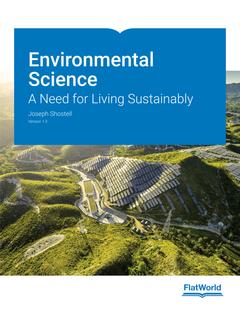
“No matter the size of the environmental issue, history has chronicled how the actions of individuals and groups of people have led to positive environmental change.”
This is just one excerpt from University of Minnesota Crookston Math, Science, & Technology Department chair and professor Joseph Shostell’s recently published textbook Environmental Science: A Need for Living Sustainably v1.0. The textbook discusses environmental challenges and has seven interconnected themes with subject matters such as preserving biodiversity and the value of renewable energy.
Shostell, who has a doctorate in environmental biology and masters in zoology, says the idea for the textbook first came about in the mid-2010s when he was contacted by publishing company Flatworld to see if he was interested in writing a textbook on environmental science. Flatworld wanted to review a sample chapter before any contract would be signed and, because Shostell has an extensive research and teaching background in aquatics, he opted to write a sample chapter about water. The publishing company reviewed the chapter, liked it, and drew up a contract. Five years later the textbook was published.
“Basically, I wanted to create better learning experiences for today’s nonscience students,” Shostell explained when asked about the need for a new environmental science textbook. “It is important to recognize that these students chose other majors besides science, and many of these students are nervous about enrolling in a science class.”
“I also wanted to create a book that was up to date,” he added. “For instance, the book includes the Ukraine war which is currently having an effect on global food security.”

Environmental Science: A Need for Living Sustainably v1.0 has a narrative style of writing as well as an engaging story at the beginning of each chapter to appeal to students. The story is then revisited several times throughout the chapter and wrapped up at the end. Based on Shostell’s teaching experience, many environmental science students have difficulty seeing the relevance of the environment in their own lives. To help address this, he included home activities in every chapter. For example, a student can determine the concentration of ozone in their hometown or find out how close their home is to the nearest windmill or nuclear power plant.
Writing a college textbook and the number of levels of review needed to produce a quality product adds to the depth of the process, Shostell outlined. The process with Shostell and Flatworld included sending out each chapter to anonymous reviewers and then taking in the comments to produce the final iteration of the book.
“After these reviews and subsequent revision of eighteen chapters, I thought I was close to the finishing line,” Shostell thought. “I knew that a copy editor would review the chapters too, but I did not consider the depth of their review. They reviewed every word.”
“What great constructive feedback and a great learning experience for me,” he shared. “Often, as we become more seasoned scholars, we don’t receive the constructive feedback needed to improve our writing. I relished this part of the process.”
Shostell said book projects like his can take a long time to complete and even though he was teaching and doing research at the time, some days he would spend six to eight hours on the book. In the beginning, he added, he would set his alarm for 4 a.m. because he needed “complete quietude.”
“By the way, one of the reasons why I decided to write for Flatworld rather than another publisher was because they were offering affordable textbooks at a time when college textbooks had become, quite simply, outrageously expensive,” Shostell disclosed. “A student can obtain an electronic copy of the book from Flatworld for about thirty-two dollars.”
Shostell’s textbook can be viewed or purchased online Environmental Science: A Need for Living Sustainably v1.0 chapters include (1) Introduction to Environmental Science: Sustainability, (2) Environmental Ethics, Law, and Policy, (3) Matter, Energy, and the Environment, (4) Evolution, Populations, and Communities, (5) Ecosystems and Biomes, (6) Human Populations, (7) Preserving Biodiversity, (8) Agriculture, Food, and the Environment, (9) Sustainable Management of Forests, Grasslands, and Protected Areas, (10) Water Resources, (11) Air Quality, Climate Change, and Air Pollution, (12) Geology and Mineral Resources, (13) Nonrenewable Energy Sources, (14) Renewable Energy Sources, (15) Environmental Health and Toxicology, (16) Solid and Hazardous Waste, (17) Sustainable Community Development and Urbanization, and (18) Sustainable Economics.


